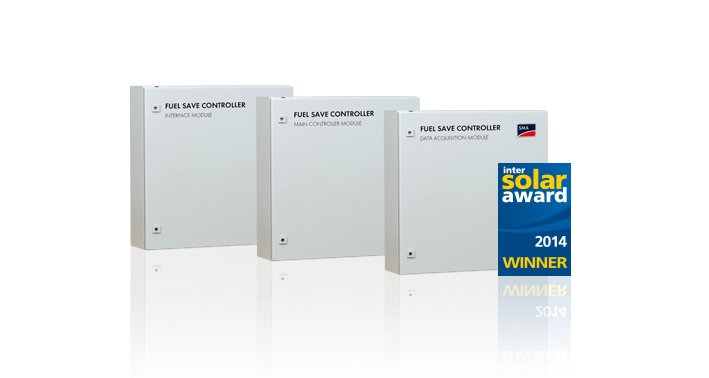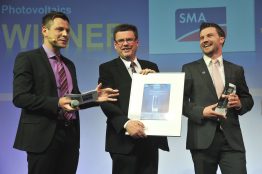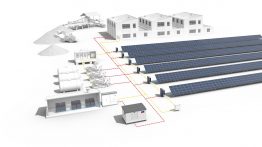How to integrate solar systems into diesel genset networks

We have already introduced the SMA solution for solar diesel hybrid systems. Its central component is the Fuel Save Controller. To learn more what this does, how it works in a PV diesel hybrid system and what makes it so special, I turned to Product Manager Johannes Weide.
Johannes, just briefly, what is the SMA Fuel Save Controller and what can it do?
The Fuel Save Controller is an intelligent control system that makes it possible to integrate PV systems into diesel genset networks. It consists of three different modules: the interface module, data acquisition module and PV main controller module. It costs considerably more to supply energy with diesel gensets than with a PV system. This makes a hybrid system economically very attractive. The challenge is to achieve a high proportion of PV without impairing the stability of the grid, as can happen, for example, if a bank of clouds rolls in and interrupts the PV output. As the brain of a hybrid system, the Fuel Save Controller monitors the flow of energy throughout the system, managing the PV system to ensure that a passing cloud or the switching of heavy loads does not affect grid stability.

Johannes Weide (right) and Volker Wachenfeld (middle) received the Intersolar AWARD in the “Photovoltaics” category for the SMA Fuel Save Controller at Intersolar Europe 2014 in Munich.
What makes this solution unique?
The control unit, the PV inverter and the battery inverter come from a single source and are thoroughly tested as a complete system in our Testing Center. From the diesel generator to the battery container, we have everything we need to test a wide variety of system configurations under real-life conditions. This was enormously helpful as the Fuel Save Controller was being developed.
With its modular design, the Fuel Save Solution can be used in from a few hundred kilowatt to the multi-megawatt range. The modular design also ensures that the system can be expanded at any time, either by enlarging the PV system or by adding battery inverters to save additional diesel costs.
Every product has its own story. Tell us how the FSC came to be.
With the multicluster technology found in the SMA Sunny Island, SMA has long been able to produce hybrid systems of up to a few hundred kilowatts. As a result, we have been working for years on how to integrate PV systems into diesel systems in the megawatt range as well.
However, in addition to technical feasibility, there is always the question of making a product financially attractive. As the price of PV systems markedly declined and the cost of diesel rose in recent years, this business case has become interesting. That was the signal for us to move forward, and SMA established a separate division to be well positioned for this market. In 2012, we installed the first Fuel Save Controller System, and now we are working on integrating batteries to save even more fuel.
Can you give us a particularly interesting example of where the Fuel Save Controller has been installed?
The Fuel Save Solution can be used in a wide variety of systems. For example, we have a very small PV diesel hybrid system at the Athens Zoo, where it is employed for training purposes. Even larger installations are also possible, such as the PV diesel hybrid system in Tonga. This is one of our first Fuel Save Controller systems in Oceania. In the islands of the tropical Pacific Ocean, most of the energy is supplied by diesel gensets, a costly solution that also results in high CO2 emissions.
The Kingdom of Tonga has set a goal of meeting its energy needs more sustainably. The Tonga Energy Road Map Agency (TERM) is responsible for this program. The FSC system installed on Vava’u, the main island of Tonga’s second largest archipelago, is an important milestone along the way. The FSC system meets approximately 13 percent of the island’s power demand, contributing to the energy transition in Oceania. Throughout the region, this project and the road map behind it are regarded as a lighthouse project, because it shows that safe, economical energy from renewables can be smoothly integrated into the existing power generation system.
You also represented SMA at the Intersolar trade fair in Germany, staffing the Fuel Save System booth. What was the question you heard most often?
People at Intersolar were very interested in the FSC. Two of the most important topics were the integration of batteries into the Fuel Save Controller systems and the possibility of later expanding the PV system. With its modular design, the FSC is a terrific solution for these needs.
And what does the future hold?
Right now, we’re building the first Fuel Save Controller systems that include battery systems. This makes it possible to use more PV energy and optimize the operation of the diesel gensets, because short peak loads can be covered by the battery inverter. As a result, we can build larger and more flexible systems.
Finally: Do you have a funny anecdote related to the Fuel Save Controller?
Once when we were commissioning the Fuel Save Controller, the system operator asked a lot of questions about exactly how the FSC worked. Then he went over to the PV inverters to see whether they were really operating at full power. Hearing hardly any noise at all, he thought something was wrong. He was all the more delighted to see on the display that the inverters were in fact supplying full nominal power.
Thank you very much for the interview and good luck.
Read more
What is a photovoltaic hybrid system? (article)
PV diesel hybrid systems – 3 designs (article)
5 steps to a PV diesel hybrid system (article)
PV Diesel hybrid applications (SMA website)
Start the
Web-based training “Industrial hybrid energy solution”
Or watch our video about the SMA Fuel Save Solution


Our company has 6.3 KV bus-bars, the bus-bars receive power generation from 6 HFO sets (each of them with capacity around 8.8 MW with 6.3 KV output), and The factory is not connected to any external electrical network (Grid) .
At nowadays, and due to several circumstances, the company has to stop the production but still have to keep some non-operational loads working, we have to operate one generator with low load less than 1.5 MW and waste fuel and not recommended at all, our company is considering installing a solar energy system with a capacity of about 1.5 MW to feed actual loads at an average rate of 1 MW to respond to the low loads scenario.
Challenges:
– Generation and distribution bus-bars are integrated (same for generation and distribution)
– The solar system is required to work when the generating sets are completely stopped during day time, it may be with Limited storage energy or with a small capacity generator as possible.
– The proposed solar power system shall operate as a support for the generation set when any of them is on line.
– The loads required to be fed during stopping the production process are distributed throughout the factory, and therefore it is necessary to use the distribution network that is already available in the factory.
The question:
Is it possible to design a solar system that meets these requirements, and if there is any solar inverters can support this design/option?
Hello Abdalrahman,
Please get back to our SMA Service for further technical support as we need further technical information in that case.
Sunny regards
Christiane
How would a HYCON respond to imbalanced loads when on PV and diesel generator. Example…D.G capacity- 200kVA ;PV capacity 95kW; Loads 70kWtot. Loads distributed across the phases as follows:L1-30kW; L2-15kW;L3-25kW.? How would this situation affect the generator.?
Hello Dixon,
Please get back to our SMA Service via our SMA Online Service Center for further support.
Sunny regards
Christiane
Hello Christiane,
I tried to access SMA Service but I couldn’t
Regards,
Abdalrahman
Hello Abdalrahman,
After successful registration, you will get in contact with the SMA Service Experts.
Sunny regards
Christiane
Unique idea. It is high time for such innovations.
https://www.thegeneratorlab.com/best-rv-generator-reviews/
good
we placed the project of 1MW, with DG back up only, i am looking forward to like this system, it is really wonderful
Please let me know if you have controllers able to operate/form an isolated grid with a maximum load of 0.9 MW, 1.8 MW of diesel generation and expected installation of 2.0 MW of solar systems with storage, in order to reach very high penetration of renewable energy.
Best,
Luis M.
Hello Luis,
please have a look at our Fuel Save Solution – Info Package. If you need more help with this topic, just send us an email at FuelSaveSolution@sma.de
Kind regards, Jennifer
Thanks for share this article, it very useful for me.
I look forward to your new article.
Dear Riley,
thanks a lot for the kind feedback 🙂
Sunny regards,
Christian
Please let me know if you have controllers able to operate/form an isolated grid with a maximum load of 0.9 MW, 1.8 MW of diesel generation and expected installation of 2.0 MW of solar systems with storage, in order to reach very high penetration of renewable energy.
Best,
Luis M.
This is an awesome idea. Is this applicable in RV applications?
Hi Chris,
Sorry for the late reply.
The Fuel Save Controller is an industrial scale solution and typically not for mobile operations – it is available for system sizes of 100kW to 50MW.
Kind regards,
Julia
That’s really great solution is it start from 100kw only. we wants to use how can purchase from SMA for our local project can you help me
Hello Walid,
Please get back to our colleagues here or contact us again in case further support is requested.
Sunny regards
Christiane